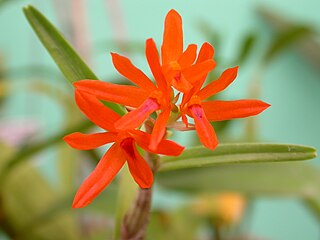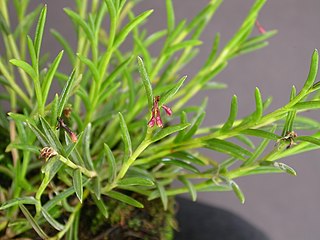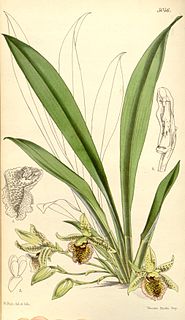
The taxonomy of the Orchidaceae has evolved slowly during the last 250 years, starting with Carl Linnaeus who in 1753 recognized eight genera. De Jussieu recognized the Orchidaceae as a separate family in his Genera Plantarum in 1789. Olof Swartz recognized 25 genera in 1800. Louis Claude Richard provided us in 1817 with the descriptive terminology of the orchids.. The next step was taken in 1830-1840 by John Lindley, who recognized four subfamilies. He is generally recognized as the father of orchid taxonomy. The next important step was taken by George Bentham with a new classification, recognizing subtribes for the first time. This classification was first presented in a paper that Bentham read to the Royal Society in 1881. Then it was published in 1883 in the final volume of Genera Plantarum. The next great contributors were Pfitzer (1887), Schlechter (1926), Mansfeld (1937), Dressler and Dodson (1960), Garay, Vermeulen (1966), again Dressler (1981). and Burns-Balogh and Funk (1986). Dressler's 1993 book had considerable influence on later work.

Epidendrum, abbreviated Epi in the horticultural trade, is a large neotropical genus of the orchid family. With more than 1,500 species, some authors describe it as a mega-genus. The genus name refers to its epiphytic growth habit.

Bridelia is a plant genus of the family Phyllanthaceae first described as a genus in 1806. It is widespread across Africa, Australia, southern Asia, and various islands of the Indian and Pacific Oceans.

Laeliinae is a Neotropical subtribe including 40 orchid genera, such as Brassavola, Laelia and Cattleya. The genus Epidendrum is the largest within this subtribe, containing about 1500 species. This is followed by the genus Encyclia, with over 120 species.
A conserved name or nomen conservandum is a scientific name that has specific nomenclatural protection. That is, the name is retained, even though it violates one or more rules which would otherwise prevent it from being legitimate. Nomen conservandum is a Latin term, meaning "a name to be conserved". The terms are often used interchangeably, such as by the International Code of Nomenclature for Algae, Fungi, and Plants (ICN), while the International Code of Zoological Nomenclature favours the term "conserved name".
Calaway Homer Dodson was an American botanist, orchidologist, and taxonomist.

Epidendrum secundum, one of the crucifix orchids, is a poorly understood reed stemmed species, which Dressler (1989) describes as "the Epidendrum secundum complex." According to Dressler, there are dozens of varieties, some of which appear to deserve species rank. Arditti and Ghani note that E. secundum has the distinction of bearing the longest seeds known in the Orchidaceae, 6.0 mm long. By comparison, the seeds of E. ibaguense are only 2.9 mm long.

Scaphyglottis is a genus of orchids native to Mexico, Central America, northern South America and parts of the Caribbean. The current concept of this genus is the result of combining several genera which have been described at various times. The concept is characterized by the growth habit: not only are new pseudobulbs added at the base of the old ones, but new pseudobulbs also grow at the apices of the old ones. Many species are quite similar and difficult to distinguish, but some are clearly distinct. A few have showy colors. The genus comprises nearly 70 species.

Orthochilus mechowii is a species of orchid. It occurs from Nigeria to Western Ethiopia and South Africa. It was previously known as Eulophia mechowii until recently transferred back to the genus Orthochilus.

Scaphyglottis bidentata is a species of orchid found in the American tropics from Costa Rica to northern Brazil. It is the type species of the genus Hexisea, and was published before the generic epithet Scaphyglottis. In a reversal of the usual rules for taxonomy, the genus Scaphyglotts was conserved against Hexisea when the two genera were combined. The generic epithet Hexisea was retained as correct, however, in discussions limited to the species which had traditionally been placed in Hexisea.

Cischweinfia is a genus of flowering plants from the orchid family, Orchidaceae. It was named after Harvard orchidologist Charles Schweinfurth. It has eleven currently recognized species, all native to Central America and northwestern South America.

Galeottia is a genus of flowering plants from the orchid family, Orchidaceae. It is native to South America, Central America and southern Mexico.
- Galeottia acuminata(C.Schweinf.) Dressler & Christenson
- Galeottia antioquiana(Kraenzl.) Dressler & Christenson
- Galeottia burkei(Rchb.f.) Dressler & Christenson
- Galeottia ciliata(C.Morel) Dressler & Christenson
- Galeottia colombiana(Garay) Dressler & Christenson
- Galeottia fimbriata(Linden & Rchb.f.) Schltr.
- Galeottia grandifloraA.Rich.
- Galeottia jorisiana(Rolfe) Schltr.
- Galeottia marginata(Garay) Dressler & Christenson
- Galeottia negrensisSchltr.
- Galeottia peruvianaD.E.Benn. & Christenson
- Galeottia prainiana(Rolfe) Dressler & Christenson

Jacquiniella is a genus of flowering plants from the orchid family, Orchidaceae. It is native to Mexico, Central America, the West Indies, and South America.

Kefersteinia is a genus of flowering plants from the orchid family, Orchidaceae. It has about 40-50 species, widespread across much of Latin America. The genus was named for Keferstein of Kröllwitz, an orchidologist.
Systeloglossum is a genus of flowering plants from the orchid family, Orchidaceae. It contains 5 known species, all native to southeastern Central America and northwestern South America.
- Systeloglossum acuminatumAmes & C.Schweinf. - Costa Rica, Panama
- Systeloglossum bennettii(Garay) Dressler & N.H.Williams - Peru
- Systeloglossum costaricenseSchltr. - Peru
- Systeloglossum ecuadorense(Garay) Dressler & N.H.Williams - Ecuador
- Systeloglossum panamenseDressler & N.H.Williams - Panama

Dendrobieae is a tribe in the subfamily Epidendroideae, in the family Orchidaceae.
Scaphyglottis atwoodii is a species of epiphytic orchid from Costa Rica. It is known from only one location at Finca de Selva, 3 km east of Puerto Viejo de Sarapiquí.

Carolus Adrianus Johannes "Karel" Kreutz is a Dutch orchidologist, botanical writer and taxonomist, currently affiliated with the Centre for Biodiversity Naturalis in Leiden, Netherlands. He is regarded as an exceptionally experienced orchidologist, and has published orchid floras of Cyprus, Turkey, Rhodes, Crimea, Netherlands, Belgium and Germany, and is currently preparing a major overview in ten volumes of all Orchid taxa in Europe, North Africa and the Middle East, employing modern taxonomy, nomenclature and research techniques.

Coniopteris is an extinct genus of Mesozoic fern leaves with a fossil range from the Early Jurassic to the Cenomanian stage of the Late Cretaceous. It was widespread over both hemispheres during the Jurassic and Early Cretaceous, with over 130 species having been described.














